
The First Armenian Scholarly Publication in the Field of Museology in an Internationally Recognized Journal
08.11.2025
A museological article by researchers of the Armenian Genocide Museum-Institute, Doctor of Historical Sciences Gevorg Vardanyan and Seda Parsamyan, has been published in the prestigious international journal Museum Worlds.
In their article, the authors discuss the temporary exhibition “The Armenian Woman: Victim and Heroine of the Armenian Genocide,” organized more than a year ago at the Armenian Genocide Museum. The exhibition achieved exceptional success, being presented not only in Armenia but also in many countries worldwide, including the United States, where, in cooperation with the Zoryan Institute, it was showcased at Arizona State University.
This marks perhaps the first instance in the post-Soviet period that Armenian scholars have been published in a peer-reviewed, internationally recognized museology journal.

An article co-authored by AGMI researcher Arman Khachatryan has been published in a leading international peer-reviewed journal
04.10.2025
We are pleased to announce that Dr. Arman Khachatryan (second author), a researcher at the Armenian Genocide Museum-Institute, together with his colleague Manuk Avedikyan (first author) from the Institute of Armenian Studies at the University of Southern California, has published a peer-reviewed article, titled “Armenian Genocide Oral History as an Archival Source” in Archival Science, a leading international peer-reviewed journal in the field of archival and heritage studies (Q1, H-index: 44, Impact Factor (2025): ~2.1). The article appears in the special issue “Archives of Resilience: Locating and Interpreting Post-Ottoman Minority Sources,” co-edited by Dr. Alexis Rappas and Dr. Angelos Dalachanis.
This important contribution addresses a significant gap by exploring the creation and development of Armenian Genocide survivor oral history collections since the 1960s. It further examines the challenges, uses, and scholarly value of oral histories in Armenian Genocide research.

“Witnesses: Documenting the Crime — Eyewitness Documentarians of the Armenian Genocide” Exhibition in Katowice, Poland
30.09.2025
On September 27, within the framework of the 4th Armenian Culture Festival held in Katowice, Poland, the exhibition titled “Witnesses: Documenting the Crime — Eyewitness Documentarians of the Armenian Genocide” was opened. The exhibition was dedicated to the 110th anniversary of the Armenian Genocide and the 20th anniversary of the resolution adopted by the Sejm of the Republic of Poland condemning the Armenian Genocide.
The exhibition was prepared in cooperation with the Armenian Genocide Museum-Institute within the framework of the commemorative events marking the 110th anniversary of the Armenian Genocide (in Armenian and Polish). It presents a large collection of testimonies by missionaries, doctors, diplomats, and military figures that document the Armenian Genocide and reveal its scale, while also highlighting the humanitarian actions carried out during that horrific crime.

Renowned French Genocide Scholar Yves Ternon Awarded the RAFFAELE LEMKIN Commemorative Medal by the AGMI
26.09.2025
Director of the Armenian Genocide Museum-Institute (AGMI), Dr. Edita Gzoyan, awarded Dr. Yves Ternon, a renowned French genocide scholar, with the AGMI Raphael Lemkin Commemorative Medal for his significant contribution and in-depth research in the field of Armenian Genocide studies.
The award ceremony took place within the framework of the international training course titled “Interrogating the ‘Never Again’: The Holocaust and Mass Atrocities”, held in Yerevan from September 24 to 26.
The course was jointly organized by Yerevan State University, the Embassies of France and Germany in Armenia, and the Shoah Memorial in Paris. The second day of the seminar was entirely hosted at the Armenian Genocide Museum-Institute, focusing on the study of the Armenian Genocide and the Nagorno-Karabakh issue.

Italian Delegation in Armenia for the 108th NATO Parliamentary Assembly Rose-Roth Seminar Visits the Armenian Genocide Memorial Complex
23.09.2025
On 23 September, an Italian delegation visiting Armenia to participate in the 108th NATO Parliamentary Assembly Rose-Roth Seminar — including Members of the Chamber of Deputies, Senators of the Italian Parliament and other representatives — visited the Armenian Genocide Memorial Complex, accompanied by Maria Karapetyan, Head of the Armenia–Italy Friendship Group in the National Assembly of Armenia.
The guests were received by Lusine Abrahamyan, Deputy Director for Museum Affairs at the Armenian Genocide Museum-Institute. She guided the delegation through the Memorial Complex, presenting the history of its creation. Abrahamyan also highlighted the three khachkars (cross-stones) commemorating Armenians who fell victim to massacres organized by the Azerbaijani government in Sumgait, Kirovabad (Ganzak) and Baku at the end of the last century, as well as the five freedom fighters buried opposite the Memorial Wall during the Artsakh Liberation War — underscoring the link between those events and the Armenian Genocide.

Delegation of the French Army’s Land Forces for Culture and Monument Preservation Visits the Armenian Genocide Memorial Complex
20.09.2025
On 20 September, the Delegation of the French Army’s Land Forces for Culture and Monument Preservation paid an official visit to the Armenian Genocide Memorial Complex.
The guests were welcomed by Dr. Edita Gzoyan, Director of the Armenian Genocide Museum-Institute, who accompanied them to the memorial and outlined the history of its creation. Dr. Gzoyan also spoke about the three khachkars (cross-stones) commemorating Armenians killed in the massacres organized by the Azerbaijani government in Sumgait, Kirovabad (Gandzak) and Baku at the end of the last century, as well as about five freedom fighters from the Artsakh Liberation War buried opposite the Memorial Wall. She emphasized the links between those events and the Armenian Genocide.
At the Eternal Flame, the delegation honored the memory of the victims of the Armenian Genocide with a minute of silence.
Dr. Gzoyan then led the visitors to the Memorial Wall, where small urns containing soil from the graves of foreign public figures, politicians, intellectuals and missionaries are placed in special niches.

New Additions to the AGMI Collection
19.09.2025
The Armenian Genocide Museum-Institute has received a donation from Lebanese-Armenian artist Jacqueline Ohanian: her 2024 painting “From Ashes to Memory”.
The artist personally traveled from Beirut to Yerevan to present the work. Ohanyan has held numerous solo exhibitions in the United States, the United Arab Emirates and Lebanon, and has participated in various international biennales.
She also donated a graphic work by Lebanese-Armenian artist Jean Guvderelyan (Guvder, 1923–2016), titled Gray Family (2004).
Both Jacqueline Ohanian and Guvder are descendants of Armenian Genocide survivors.

AGMI Researcher Narek Poghosyan Attends International Conference
18.09.2025
On 25–26 August, Narek Poghosyan, a researcher at the Armenian Genocide Museum-Institute, participated in the Second International Conference “The Genocide of the Kurds: Its Reflection in Literature, Art and the Media” held in Sulaymaniyah, Iraq.
Poghosyan presented a paper titled “The Legacy of Trauma: A Comparative Analysis of the Memory of the Armenian Genocide and Anfal”.

Delegation from Germany’s Federal Ministry for the Environment Visits the Armenian Genocide Memorial
16.09.2025
On 16 September, a delegation from Germany’s Federal Ministry for the Environment and Nature Conservation visited the Armenian Genocide Memorial.
The guests were welcomed by Lusine Abrahamyan, Deputy Director of the Armenian Genocide Museum-Institute for Museum Affairs, who guided them through the Memorial and presented its history. She also highlighted the three khachkars on the Tsitsernakaberd grounds commemorating Armenians killed in massacres organized by Azerbaijani authorities at the end of the last century in Sumgait, Kirovabad (Gandzak), and Baku, as well as the five freedom fighters buried opposite the Memorial Wall during the Artsakh Liberation War, emphasizing the connection between these events and the Armenian Genocide.

Brendan H. Henry, Head of the U.S. Department of State’s Bureau of European and Eurasian Affairs, Visits the Armenian Genocide Memorial
12.09.2025
On 12 September, a delegation led by Brendan H. Henry, Head of the Bureau of European and Eurasian Affairs at the U.S. Department of State, visited the Armenian Genocide Memorial.
The guests were welcomed by Edita Gzoyan, Director of the Armenian Genocide Museum-Institute, who guided them through the Memorial and shared its history. She also highlighted the three khachkars (cross-stones) on the Tsitsernakaberd grounds commemorating Armenians killed in massacres organized by Azerbaijani authorities at the end of the last century in Sumgait, Kirovabad (Gandzak), and Baku, as well as the five freedom fighters buried opposite the Memorial Wall during the Artsakh Liberation War, emphasizing the connection between these events and the Armenian Genocide.

The Armenian Genocide Museum’s Main Exhibition Guide Now Available in Four Languages
10.09.2025
The Armenian Genocide Museum-Institute has recently published the guide to its main exhibition in English, Russian, French, and German. Richly illustrated and filled with extensive documentary material and contemporary press accounts, the guide presents the history of the Armenian Genocide and its impact on the Armenian people in an accessible and engaging format.
The guide is now included among the books presented to visiting delegations and high-ranking guests at the Armenian Genocide Memorial.

Suren Manukyan Lectures, Satenik Matosyan and Anna Kazaryan Participate in Zoryan Institute’s Genocide and Human Rights Program
03.09.2025
Junior researchers from the Armenian Genocide Museum-Institute, Satenik Matosyan and Anna Kazaryan, took part in the Zoryan Institute’s Genocide and Human Rights University Program at the University of Toronto from 28 July to 8 August. This year’s program brought together researchers from 11 countries.
Over the ten-day program, participants explored the origins and development of human rights, theories and definitions of genocide, the psychology of perpetrators, the study of the Armenian Genocide, and the evolution of international law. Case studies also included the Holocaust, the Rwandan genocide, and genocides affecting Indigenous peoples in North America.

Delegation from the Swedish Riksdag Visits the Armenian Genocide Memorial
02.09.2025
On 2 September, a delegation from the Swedish Riksdag visited the Armenian Genocide Memorial, accompanied by Ruben Rubinyan, Vice President of the National Assembly of Armenia, and Vladimir Vardanyan, Chair of the Standing Committee on State-Legal Affairs.
The guests were welcomed by Edita Gzoyan, Director of the Armenian Genocide Museum-Institute, who guided them through the Memorial and shared its history. She also highlighted the three khachkars (cross-stones) on the Tsitsernakaberd grounds commemorating Armenians killed in massacres organized by Azerbaijani authorities at the end of the last century in Sumgait, Kirovabad (Gandzak), and Baku, as well as the five freedom fighters buried opposite the Memorial Wall during the Artsakh Liberation War, emphasizing the connection between these events and the Armenian Genocide.

Chinese and German Audio Guides Introduced at the Armenian Genocide Museum
01.09.2025
The Armenian Genocide Museum has recently introduced audio guides in Chinese and German, responding to the growing number of tourists visiting Armenia from these countries.
The Museum-Institute expresses its deep gratitude to the Gishyan Foundation, whose grant made it possible to acquire new, state-of-the-art audio and radio guide systems. Appreciation is also extended to the Embassy of Germany in Armenia for financing the translation and editing of the German texts, and to the Yerevan State University of Languages and Social Sciences named after V. Bryusov for their work on translating and editing the Chinese texts.

Original Photograph of Gevorg Chaush’s Widow, Heghine (Yeghso) Chaush, Donated to the Armenian Genocide Museum-Institute
30.08.2025
The Armenian Genocide Museum-Institute has recently received, as a donation, the original photograph of Heghine (Yeghso) Chaush, widow of the legendary Armenian fedayee Gevorg Chaush.
The photograph was donated by Murad Uchaner, who accidentally discovered it in 2005 in one of Antep’s historic districts, concealed within the wall of an old house during restoration works.
In the image, Heghine Chaush is depicted holding a pistol in one hand and a rifle in the other, with cartridge belts draped across her chest and waist. The photo was taken in 1910, after her husband’s death, at the M. H. Halladjian photography studio in Antep. On the reverse side, a handwritten dedication reads: “Mrs. Heghine, widow of the late hero Gevorg Chaush. Our commemorative gift [illegible word] Mr. Hovhannes and Mrs. Pidania. July 21, 1910, ARF, Antep.”
The love story of Gevorg and Heghine is remembered as a profound expression of devotion. In 1905, despite many obstacles and in defiance of fedayee laws, the couple married. Following her husband’s death, Heghine and their only son were relentlessly persecuted by the Ottoman authorities, enduring severe hardships.

The Lament of Karapet Artinian
27.08.2025
The Armenian Genocide Museum-Institute has recently received a significant donation from the Artinian family of the United States: the handwritten lament composed by Karapet Artinian (1879–1925), a survivor of the 1909 Adana massacres. The manuscript, preserved by the family for more than a century, was donated to the Museum by his great-grandson, Robert Artinian, in accordance with the unanimous decision of the descendants.
In June 1909, having lost his wife and child in the Adana massacres, Karapet Artinian composed this lament in Armeno-Turkish, presenting the atrocities in chronological sequence. The work, consisting of fifty-seven quatrains and written in the third person, belongs to the genre of the destan. Originating in Persian tradition, the destan was widely cultivated in the Ottoman Empire to recount heroic deeds, romances, and, at times, profound tragedies. Its secular character allowed it to be embraced by diverse religious communities—Armenians, Greeks, Assyrians, Jews, and Muslims alike.

LECTURE ON “THEOLOGY AND THE ARMENIAN GENOCIDE” AT THE AGMI
21.08.2025
On August 5, participants of the Theological Summer Academy “Historical Narratives and Contemporary Challenges: Culture, Religion, and Society in Armenia”—representing Armenia, Münster, Tbilisi (Georgia), Halle, Leipzig, and Berlin—visited the Armenian Genocide Museum-Institute.
As part of the visit, Dr. Shushan Khachatryan, Head of the AGMI Department for the Documentation and Research of Armenian Genocide Victims and Survivors, theologian, Ph.D., delivered a lecture titled “Theology and the Armenian Genocide.” In her presentation, she outlined key theological perspectives on genocide, focusing on the following themes:
• Theodicy and Anthropodicy in the Context of Genocide – the challenge of reconciling faith in a Loving, Merciful, and Almighty God with the reality of evil, suffering, and atrocity, along with the conceptual difficulties surrounding the notion of “human.”

Article by Dr. Harutyun Marutyan Published in an Internationally Renowned Journal
28.07.2025
An article by Dr. Harutyun Marutyan, Head of Department at the Armenian Genocide Museum-Institute and Chief Researcher at the Institute of Archaeology and Ethnography of the National Academy of Sciences of Armenia (NAS RA), has been published in a highly esteemed international academic volume by Brill.
The article, titled “Commemorative Practices and Memorial Sites: The Armenian Genocide Memorial”, appears as an individual chapter in the more than 380-page collective volume “Pathways to Agonism: Disputed Territories and Memory” (edited by Christina Horvath and Tomasz Rawski) — the sixth volume in the Mobilizing Memories book series.
In this article, Dr. Marutyan provides an in-depth analysis of the Armenian Genocide Memorial Complex, exploring its constituent elements and their significance as enduring symbols of the inseparable links between the past and the present.

NEW BOOK MARKING THE 110TH ANNIVERSARY OF THE ARMENIAN GENOCIDE:
“Commemorating the Armenian Genocide”
11.07.2025
We are pleased to announce that the approximately 300-page monograph “Commemorating the Armenian Genocide” by Dr. Harutyun Marutyan, Head of Department at the Armenian Genocide Museum-Institute and Chief Researcher at the Institute of Archaeology and Ethnography of the National Academy of Sciences of Armenia (NAS RA), is now available for pre-order.
(The author of the introduction is Levon Abrahamian, Corresponding Member of the NAS RA.)
The work is being published as part of the academic series “Armenians in the Modern and Early Modern World”, edited by Professor Bedross Der Matossian of the University of Nebraska–Lincoln, Department of History and Middle Eastern Studies. (For more details, see: https://www.bloomsbury.com/us/series/armenians-in-the-modern-and-early-modern-world). The monograph will be published by I.B. Tauris, an imprint of Bloomsbury Publishing.
For further information, visit: https://www.bloomsbury.com/uk/commemorating-the-armenian-genocide-9780755657216/.

Students of the Geneva Academy of International Humanitarian Law and Human Rights Visit the Armenian Genocide Museum-Institute
04.07.2025
A group of around twenty students from the Geneva Academy of International Humanitarian Law and Human Rights, visiting Armenia on a study trip, toured the Armenian Genocide Museum-Institute.
The students took part in a discussion on the Armenian Genocide and the phenomenon of genocide in general with Harutyun Marutyan, Head of the AGMI Department for the Study of the Oppression of Armenians in Artsakh, Nakhichevan, and other Armenian-populated regions of Azerbaijan; Suren Manukyan, Head of the V. Dadrian Department of Comparative Genocide Studies; Narek Poghosyan, researcher at the same department; and Robert Tatoyan, researcher at the Department of Source Studies on the Armenian Genocide. The discussion also touched upon the forced displacement of Armenians from Artsakh, Azerbaijan’s state-sponsored anti-Armenian policies, as well as the ongoing situation in Gaza.

Belgian Foreign Ministry Delegation Visits the Armenian Genocide Memorial
02.07.2025
A delegation from the Ministry of Foreign Affairs of the Kingdom of Belgium, led by Birgit Stevens, Director General for Bilateral Relations, and Philippe Benoit, Director for Eastern and Southeastern Europe and Central Asia, visited the Armenian Genocide Memorial on July 2. They were accompanied by H.E. Eric de Muynck, Ambassador of Belgium to Armenia.
The guests were welcomed by Lusine Abrahamyan, Deputy Director of the Armenian Genocide Museum-Institute, who presented the history of the Memorial and highlighted the stories of the three cross-stones commemorating Armenians massacred in Sumgait, Kirovabad (Ganja), and Baku, as well as the five freedom fighters buried near the Memorial Wall during the Artsakh war. She emphasized the connection between these tragedies and the Armenian Genocide.
The delegation laid flowers at the Eternal Flame and honored the memory of the victims with a minute of silence.

Inesa Stepanyan, Head of Educational Programs at the Armenian Genocide Museum-Institute, Conducts Research at the U.S. Library of Congress
28.06.2025
During April and May of this year, Inesa Stepanyan, Head of Educational Programs and Junior Researcher at the Armenian Genocide Museum-Institute, conducted a research visit at the U.S. Library of Congress. This trip was part of the 2024 “Support Program for Research by Postgraduate Students and Young Scholars,” organized by the Committee on Higher Education and Science.
Throughout her research and review of newly available archives, she acquired numerous valuable materials, including correspondence from various diplomatic and consular officials, press documents, and more.

Suren Manukyan Participated in the International Conference “State-Commissioned Historiography and Historiographical Authority”
27.06.2025
On June 12-13, Suren Manukyan, Head of the V. Dadryan Department of Comparative Genocide Studies at the Armenian Genocide Museum-Institute, took part in the international conference organized by the Laboratory of Philosophy and Theory of History at Yerevan State University, titled “State-Commissioned Historiography and Historiographical Authority.”
Manukyan presented a report entitled “Constructing Azerbaijani History: Narrative Shifts and the Role of State-Commissioned Historiography.” His presentation examined how state-sponsored historiography in Azerbaijan has become a strategic tool to manipulate public memory and promote anti-Armenian policies. Special focus was given to contemporary Azerbaijani textbooks, which are filled with narratives that incite hatred against Armenians.

Commemorative Ceremony at the Armenian Genocide Memorial:
Soil from Raphael Lemkin’s Grave Placed in the Memorial Wall and a Plaque Unveiled in His Honor
24.06.2025
On June 24, a solemn ceremony was held at the Armenian Genocide Memorial to mark the 110th anniversary of the Armenian Genocide and the 125th anniversary of the birth of Raphael Lemkin, the originator of the term genocide and a pioneering figure in international law. During the ceremony, soil brought from Lemkin’s grave was placed in the Memorial Wall, and a commemorative plaque bearing his name was unveiled, honoring his profound contribution to the recognition and prevention of genocides.
The event was attended by Marcin Różecki, Chargé d’Affaires of the Embassy of Poland in Armenia; His Grace Bishop Shaheh Sarkissian, Director of the “Cilicia” Manuscript Library of the Catholicosate of the Great House of Cilicia and a member of the AGMI Board of Trustees; and other dignitaries. The initiative was led by Bishop Sarkissian, who requested Archbishop Anoushavan Danielian, Prelate of the Eastern Prelacy of the Armenian Apostolic Church of America, to collect soil from Lemkin’s grave at Mount Hebron Cemetery in New York. The soil was then transferred to Beirut and brought to Armenia by Hrachya Margaryan, Director of the National Center Development Foundation.

Georgian Minister of Internal Affairs Gela Geladze Visits Armenian Genocide Memorial
23.06.2025
On June 23, a delegation led by Gela Geladze, Minister of Internal Affairs of Georgia, visited the Armenian Genocide Memorial, accompanied by Armen Ghazaryan, Deputy Minister of Internal Affairs of Armenia.
The guests were warmly welcomed by Lusine Abrahamyan, Deputy Director for Museum Affairs at the Armenian Genocide Museum-Institute. She escorted the delegation through the memorial, presenting its history. Deputy Director Abrahamyan also highlighted three khachkars (cross-stones) in the Tsitsernakaberd complex, dedicated to Armenians who were victims of massacres orchestrated by the Azerbaijani government in the late 20th century in Sumgait, Kirovabad (Gandzak), and Baku. Additionally, she shared the stories of five freedom fighters buried near the Memorial Wall who lost their lives during the Artsakh liberation struggle, emphasizing the connection between these events and the Armenian Genocide.

Delegation from the Poland-Armenia Friendship Group of the Polish Sejm Visits Armenian Genocide Memorial
20.06.2025
On June 20, a delegation led by Lucjan Pietrzczyk, head of the Poland-Armenia Friendship Group in the Sejm of the Republic of Poland, visited the Armenian Genocide Memorial.
The guests were warmly welcomed by Edita Gzoyan, Director of the Armenian Genocide Museum-Institute, who accompanied them throughout the memorial and shared the history of its establishment.

Armenian Genocide Museum-Institute Wins 2025 Grant from Stepan Gishyan Charitable Foundation
19.06.2025
We are pleased to announce that the Armenian Genocide Museum-Institute has been selected as a winner of the 2025 grant competition organized by the Stepan Gishyan Charitable Foundation. The foundation will provide support for the technical modernization of the museum.
We extend our sincere gratitude to the Stepan Gishyan Foundation for its vital mission and for supporting the Armenian Genocide Museum for the second time.

Chairman of the Georgian Parliament’s Culture Committee Giorgi Gabunia Visits Armenian Genocide Memorial
19.06.2025
On June 19, a delegation headed by Giorgi Gabunia, Chairman of the Culture Committee of the Parliament of Georgia, visited the Armenian Genocide Memorial. He was accompanied by Narek Babayan, a member of the Standing Committee on Science, Education, Culture, Diaspora, Youth, and Sports of the National Assembly of Armenia.
The guests were welcomed by Edita Gzoyan, Director of the Armenian Genocide Museum-Institute, who led them through the memorial and presented the history of its establishment.

NEW DONATION TO THE ARMENIAN GENOCIDE MUSEUM-INSTITUTE
18.06.2025
The Armenian Genocide Museum-Institute’s scientific collections continue to be enriched with rare and valuable materials. On June 18, the Museum had the honor of welcoming Dr. Vahram Shemmassian, Professor of Armenian Studies at California State University, Northridge (USA), who has dedicated decades to academic research and the collection of historical documents. A descendant of survivors from Musa Dagh, Professor Shemmassian has gathered a remarkable personal archive of unique sources related to the Armenian Genocide.
During his visit, Professor Shemmassian donated a number of exceptional items from his private collection, primarily focusing on the heroic resistance of Musa Dagh, the history of its people, and their journey of displacement and survival. Among the items were: a fundraising receipt issued by the "Relief Commission’s Fresno Committee" for the benefit of villages in Antioch following the 1909 massacres, bearing the official seal of the Patriarchate of Constantinople; two travel permits issued in 1916 by the Egyptian government to members of the Philean family for their journey from Port Said to the United States.

The Week’s Lecture Series at the Armenian Genocide Museum-Institute
14.06.2025
This week at the Armenian Genocide Museum-Institute, three academic lectures were held, presented by experts specializing in genocide studies, addressing international law as well as the historical, legal, and humanitarian aspects of the Armenian Genocide.
On June 7, Dr. Artur Simonyan, a researcher at the Leibniz Institute for East and Southeast European Studies (IOS) in Regensburg and invited senior researcher at the AGMI’s Legal Studies Department, delivered a lecture titled “Post-Soviet Policy in the History of International Law.” The presentation covered the main phases of the formation and development of international law, focusing particularly on its interpretation and methodology of application in the post-Soviet space. Dr. Simonyan noted that after the collapse of the Soviet regime, legal thought in the region primarily adopted Eurocentric approaches without adequately integrating them into the local legal culture and political realities.

The newly appointed Ambassador of Uruguay to Armenia, Silvana Leska Barolin, visited the Armenian Genocide Memorial
14.06.2025
On June 13, Silvana Leska Barolin, the newly appointed Extraordinary and Plenipotentiary Ambassador of the Eastern Republic of Uruguay to Armenia, visited the Armenian Genocide Memorial.
The ambassador was welcomed by Edita Gzoyan, Director of the Armenian Genocide Museum-Institute, who accompanied her to the memorial and presented the history of its establishment. The Director also spoke about the three khachkars (cross-stones) at Tsitsernakaberd, erected in memory of Armenians who were victims of massacres organized by the Azerbaijani government in Sumgait, Kirovabad (Gandzak), and Baku at the end of the last century, as well as the five freedom fighters buried near the Memorial Wall during the Artsakh Liberation War, emphasizing the connection between these events and the Armenian Genocide.
Ms. Leska Barolin laid flowers at the Eternal Fire and observed a minute of silence in memory of the innocent victims of the Armenian Genocide. She also toured the Armenian Genocide Museum, where, accompanied by Shushan Khachatryan, head of the Documentation and Research Department on the Armenian Genocide Victims and Survivors at AGMI, she became acquainted with the permanent and temporary exhibitions.

The Latvia-Armenia Friendship Group of the Saeima of Latvia visited the Armenian Genocide Memorial
13.06.2025
On June 13, a delegation led by Gunārs Kūtris, head of the Latvia-Armenia Friendship Group of the Saeima of the Republic of Latvia, visited the Armenian Genocide Memorial. They were accompanied by Arsen Torosyan, head of the Armenia-Latvia, Lithuania, and Estonia Friendship Group of the National Assembly of Armenia.
The guests were welcomed by Edita Gzoyan, Director of the Armenian Genocide Museum-Institute, who guided them to the memorial and presented the history of its creation. She also spoke about the three khachkars (cross-stones) at Tsitsernakaberd, erected in memory of Armenians who fell victim to massacres organized by the Azerbaijani government in Sumgait, Kirovabad (Gandzak), and Baku at the end of the last century, as well as the five freedom fighters buried near the Memorial Wall during the Artsakh Liberation War, highlighting the connection between these events and the Armenian Genocide.

World’s leading media outlets at the Armenian Genocide Museum
13.06.2025
The Armenian Genocide Museum-Institute has long been at the center of attention for international media as an important platform for memory, knowledge, and justice.
The museum maintains an open and collaborative stance in raising awareness within the global community.
Just in April and May, journalists from the United Kingdom (Reuters, UnHerd, The Daily Telegraph, TVP World, and others), Argentina, Mexico, and Brazil visited the museum. They met with the museum’s director, Edita Gzoyan, to discuss issues related to preserving the memory of the genocide, restoring justice, and the present and future of scholarly research on the Armenian Genocide.

A delegation from the National Defence College of India visited the Armenian Genocide Memorial
11.06.2025
A delegation from the National Defence College of India, led by Major General Samarth Nagar, visited the Armenian Genocide Memorial on June 11.
The guests were welcomed by Edita Gzoyan, Director of the Armenian Genocide Museum-Institute, who accompanied them to the memorial and presented the history of its establishment. The Director also spoke about the three khachkars (cross-stones) placed in memory of the Armenians who fell victim to massacres organized by the Azerbaijani government in Sumgait, Kirovabad (Gandzak), and Baku at the end of the last century, as well as about the five freedom fighters buried near the Memorial Wall during the Artsakh Liberation War—emphasizing the connection between these events and the Armenian Genocide.

Secretary General of the Council of Europe Alain Berset visited the Armenian Genocide Memorial
11.06.2025
A delegation headed by Secretary General of the Council of Europe Alain Berset visited the Armenian Genocide Memorial on June 11, accompanied by Deputy Minister of Foreign Affairs of the Republic of Armenia Mnatsakan Safaryan.
The guests were welcomed by Edita Gzoyan, Director of the Armenian Genocide Museum-Institute, who guided them to the Armenian Genocide Memorial.
Mr. Alain Berset laid a wreath at the memorial commemorating the victims of the Armenian Genocide. The guests then placed flowers at the Eternal Fire and observed a moment of silence in memory of the holy martyrs of the Armenian Genocide.

Deputy Governor of Saint Petersburg, Boris Piotrovsky, visited the Armenian Genocide Memorial
07.06.2025
The delegation led by Deputy Governor of Saint Petersburg, Boris Piotrovsky, visited the Armenian Genocide Memorial on June 7.
The guests were welcomed by Edita Gzoyan, Director of the Armenian Genocide Museum-Institute, who accompanied them to the memorial and presented the history of its establishment. The Director also spoke about the three cross-stones (khachkars) placed in the Tsitsernakaberd area in memory of Armenians who fell victim to the massacres organized by the Azerbaijani government in the late 20th century in Sumgait, Kirovabad (Gandzak), and Baku, as well as about the five freedom fighters buried in front of the Memorial Wall during the Artsakh Liberation War, emphasizing the connection between these events and the Armenian Genocide.

Essay competition dedicated to the 110th anniversary of the Armenian Genocide
06.06.2025
The Armenian Genocide Museum-Institute, the National Directorate of Public Education of Uruguay, and the AGBU Uruguay Branch announce an essay competition for high school students in Armenia and Uruguay dedicated to the 110th anniversary of the Armenian Genocide.
The first-place winners from Armenia and Uruguay, together with their mentor teachers, will travel to the United States. There, in collaboration with the Genocide Education Project, they will present their essays at various schools across the U.S. and participate in educational and cultural events.

Chairwoman of the Federation Council of the Federal Assembly of the Russian Federation, Valentina Matviyenko, visited the Armenian Genocide Memorial
06.06.2025
On an official visit to Armenia, the delegation led by Valentina Matviyenko, Chairwoman of the Federation Council of the Federal Assembly of the Russian Federation, visited the Armenian Genocide Memorial on June 6, accompanied by Alen Simonyan, President of the National Assembly of Armenia, Gurgen Arsenyan, Armenia’s Ambassador to Russia, and Sergey Kopirkin, Russia’s Ambassador to Armenia.
The guests were welcomed by Edita Gzoyan, Director of the Armenian Genocide Museum-Institute, who guided them to the Armenian Genocide Memorial.

EYEWITNESS MEMOIRS: THE LEGACY OF BODIL KATHARINE BJØRN
Book Presentation at the Armenian Genocide Museum-Institute
05.06.2025
With the financial support of the Ministry of Foreign Affairs of the Kingdom of Norway, 110 years after the Armenian Genocide, the diary entries of Norwegian missionary Bodil Biørn were translated from Old Norwegian and published in book form. These documents have primary-source value for the study of the Armenian Genocide.
The presentation of the book titled "Memoirs of an Eyewitness: The Legacy of Bodil Katharine Biørn" took place at the Armenian Genocide Museum-Institute, attended by the Ambassador Extraordinary and Plenipotentiary of the Kingdom of Norway to Armenia, Bergljot Hovland, the Honorary Consul of Norway in Armenia, historians from Armenia and abroad, among others.

A Series of Thematic Lectures at the Armenian Genocide Museum-Institute
04.06.2025
On June 3–4, the Armenian Genocide Museum-Institute hosted a series of thematic lectures by Professor Bedross Der Matossian, Chair of the Department of History and Professor of Modern Middle East History at the University of Nebraska-Lincoln.
During the two-day event, Professor Der Matossian delivered four lectures covering the following topics: “Microhistorical Approaches to the Armenian Genocide: The Case of Sahag Khabayan II”, “Interdisciplinary Approaches to Mass Violence in the Late Ottoman Empire: The Case of the Adana Massacres of 1909”, “Denial of the Armenian Genocide in the Digital Age and Beyond”, “Impunity, Lack of Humanitarian Intervention, and International Apathy: The Ethnic Cleansing of the Armenians of Artsakh in Historical Context”.

Aleshia Duncan, U.S. Department of Energy Deputy Assistant Secretary for International Nuclear Policy and Cooperation, Visited the Armenian Genocide Memorial
02.06.2025
A delegation from the U.S. Department of Energy, headed by Aleshia Duncan, Deputy Assistant Secretary for International Nuclear Policy and Cooperation, visited the Armenian Genocide Memorial.
The guests were welcomed by Edita Gzoyan, Director of the Armenian Genocide Museum-Institute, who accompanied them to the memorial and presented the history of its creation. The Director also drew attention to the three khachkars (cross-stones) placed in memory of the Armenians who fell victim to massacres orchestrated by the Azerbaijani government in Sumgait, Kirovabad (Gandzak), and Baku at the end of the last century. She also spoke about the five Armenian freedom fighters buried across from the memorial wall during the Artsakh liberation struggle, highlighting the connection between those events and the Armenian Genocide.

Delegation Led by President of Auvergne-Rhône-Alpes Region Fabrice Pannekoucke Visits the Armenian Genocide Memorial
01.06.2025
On June 1, a delegation from France's Auvergne-Rhône-Alpes region, led by its president Fabrice Pannekoucke, visited the Armenian Genocide Memorial.
The guests were welcomed by Edita Gzoyan, Director of the Armenian Genocide Museum-Institute (AGMI), who accompanied them to the Memorial and presented the history of its establishment. The AGMI Director also spoke about the three khachkars (cross-stones) placed in memory of Armenians who fell victim to the massacres organized by the Azerbaijani government in Sumgait, Kirovabad (Gandzak), and Baku in the late 20th century, as well as the five freedom fighters buried near the Memorial Wall during the Artsakh Liberation War—highlighting the connection between these events and the Armenian Genocide.

Delegation from the Hauts-de-Seine Department Visits the Armenian Genocide Memorial
31.05.2025
On May 31, a delegation from the Hauts-de-Seine Department of France visited the Armenian Genocide Memorial Complex in Tsitsernakaberd.
The guests were welcomed by Lusine Abrahamyan, Deputy Director of the Armenian Genocide Museum-Institute (AGMI) for Museum Affairs. She accompanied the delegation to the memorial, presenting the history of its creation and significance.
Deputy Director Abrahamyan also highlighted the presence of three khachkars (cross-stones) on the grounds of Tsitsernakaberd, commemorating the Armenians who were killed during the pogroms in Sumgait, Kirovabad (Gandzak), and Baku, organized by the Azerbaijani government at the end of the 20th century.

“A Century of Armenian Genocide: Studies-Legacy, Challenges, and Future”
International Conference at the Armenian Genocide Museum-Institute
31.05.2025
On May 29–31, 2025, the Armenian Genocide Museum-Institute hosted a major three-day international academic conference titled “A Century of Armenian Genocide: Studies-Legacy, Challenges, and Future”, in its conference hall. The event was organized within the framework of the 110th anniversary of the Armenian Genocide, aiming to summarize the past century of scholarly work in the field, assess achievements and ongoing challenges, and outline future directions for genocide studies.
The conference brought together 51 scholars from Armenia, the United States, France, Canada, Germany, Brazil, Israel, Poland, Australia, Lebanon, and Turkey, representing leading academic institutions and research centers worldwide.

A delegation led by Markus Rinderspacher, Vice President of the Bavarian State Parliament visited the Armenian Genocide Memorial
30.05.2025
On May 30, a delegation led by Markus Rinderspacher, Vice President of the Bavarian State Parliament (Landtag), visited the Armenian Genocide Memorial.
The guests were welcomed by Lusine Abrahamyan, Deputy Director of the Armenian Genocide Museum-Institute for Museum Affairs. She accompanied the delegation to the Memorial, presenting the history of its creation. The Deputy Director also spoke about the three khachkars (cross-stones) placed on the grounds of Tsitsernakaberd in memory of the Armenians killed in the massacres organized by the Azerbaijani government at the end of the last century in Sumgait, Kirovabad (Gandzak), and Baku, as well as the five freedom fighters buried in front of the Wall of Remembrance during the Artsakh Liberation War, highlighting the connection between these events and the Armenian Genocide.

A Century of Armenian Genocide Studies – Legacy, Challenges, and Future
29–31 May, 2025
27.05.2025
On the occasion of the 110th anniversary of the Armenian Genocide, the Armenian Genocide Museum-Institute (AGMI) will host a three-day international conference titled “A Century of Armenian Genocide Studies: Legacy, Challenges, and Future” from May 29 to 31, 2025.
The conference is expected to bring together more than 50 scholars from around the world.

Prime Minister of the Slovak Republic visited the Armenian Genocide Memorial
27.05.2025
On May 27, a delegation led by the Prime Minister of the Slovak Republic, Robert Fico, visited the Armenian Genocide Memorial, accompanied by Deputy Minister of Foreign Affairs of Armenia Vahan Kostanyan and First Deputy Mayor of Yerevan Armen Pambukhchyan.
The guests were welcomed by the Director of the Armenian Genocide Museum-Institute, Edita Gzoyan, who accompanied them to the Armenian Genocide Memorial.
The Prime Minister of Slovakia laid a wreath at the memorial commemorating the victims of the Armenian Genocide. The guests then placed flowers at the Eternal Fire and observed a minute of silence in memory of the innocent martyrs of the Armenian Genocide.

At the Memorial Wall of the Armenian Genocide Memorial Complex, a solemn ceremony was held for the placement of soil brought from the grave of French naval officer Louis Dartige du Fournet—who saved the lives of around 4,000 Armenians during the heroic resistance of Musa Dagh—and for the unveiling of his commemorative plaque
26.05.2025
On May 26, a delegation led by French Minister Delegate for Europe, Jean-Noël Barrot, visited the Armenian Genocide Memorial, accompanied by Armenia’s Minister of Foreign Affairs, Ararat Mirzoyan.
The guests were welcomed by the Director of the Armenian Genocide Museum-Institute, Edita Gzoyan, who accompanied them to the Armenian Genocide Memorial.
The Foreign Ministers of the two countries laid wreaths at the memorial commemorating the victims of the Armenian Genocide.

U.S. Deputy Assistant Secretary of State Jacob McGee visited the Armenian Genocide Memorial
26.05.2025
U.S. Deputy Assistant Secretary of State for Democracy, Human Rights, and Labor Jacob McGee visited the Armenian Genocide Memorial, accompanied by U.S. Deputy Chief of Mission in Armenia, David Allen.
The guests were welcomed by the Director of the Armenian Genocide Museum-Institute, Edita Gzoyan, who led them to the Memorial and presented the history of its creation. Ms. Gzoyan also spoke about the three khachkars (cross-stones) placed on the grounds of Tsitsernakaberd, dedicated to the victims of the anti-Armenian massacres organized by the Azerbaijani authorities in the cities of Sumgait, Kirovabad (Gandzak), and Baku at the end of the 20th century. She also shared the stories of five freedom fighters buried in front of the Memorial Wall during the Artsakh Liberation War, emphasizing the connection between these events and the Armenian Genocide.

U.S. Deputy Assistant Secretary of State Jacob McGee visited the Armenian Genocide Memorial
26.05.2025
On May 27, U.S. Deputy Assistant Secretary of State for Democracy, Human Rights, and Labor Jacob McGee visited the Armenian Genocide Memorial, accompanied by U.S. Deputy Chief of Mission in Armenia, David Allen.
The guests were welcomed by the Director of the Armenian Genocide Museum-Institute, Edita Gzoyan, who led them to the Memorial and presented the history of its creation. Ms. Gzoyan also spoke about the three khachkars (cross-stones) placed on the grounds of Tsitsernakaberd, dedicated to the victims of the anti-Armenian massacres organized by the Azerbaijani authorities in the cities of Sumgait, Kirovabad (Gandzak), and Baku at the end of the 20th century. She also shared the stories of five freedom fighters buried in front of the Memorial Wall during the Artsakh Liberation War, emphasizing the connection between these events and the Armenian Genocide.

Book Discussion at the Armenian Genocide Museum-Institute (AGMI)
24.05.2025
A book discussion was held at the Armenian Genocide Museum-Institute (AGMI) on Remnants: Embodied Archives of the Armenian Genocide (Stanford University Press, 2023), authored by Dr. Elyse Semerdjian, Chair of Armenian Genocide Studies at the Strassler Center for Holocaust and Genocide Studies, Clark University. The book was awarded the Best Book Prize in 2024 by the Association for Middle East Women’s Studies (AMEWS).
In her presentation, Elyse Semerdjian spoke about three forms of post-memory related to the Armenian Genocide: body, skin, and bones. She focused particularly on Armenian women and children who were forcibly Islamized and branded with tribal identifiers. According to the author, these fragmented bodies, tattooed skins, and bones recovered from the deserts serve as archival remnants—documenting history, violence, loss, and resistance.

Book Presentation at AGMI: “Humanitarianism and Christian Compassion: The History of German Missions Among Armenians in the Ottoman Empire (1896–1919)”
24.05.2025
At the Armenian Genocide Museum-Institute, a book presentation was held for “Humanismus und christliche Barmherzigkeit: Geschichte der deutschen Missionen für die Armenier im Osmanischen Reich 1896–1919” (“Humanitarianism and Christian Compassion: The History of German Missions for the Armenians in the Ottoman Empire, 1896–1919”) by Dr. Hayk Martirosyan, Turkologist and research fellow at the Johannes Lepsius House Archive.
The book examines the activities of six German evangelical missions as well as Catholic circles operating among Armenians in the Ottoman Empire from 1896 to 1919. In his remarks, the author noted that the idea for the book took shape during his tenure at the Armenian Genocide Museum-Institute, where he began studying the humanitarian work of German missions, later continuing his research in Germany.

Lecture
23.05.2025
We cordially invite you to attend a series of thematic lectures by Professor Bedross Der Matossian, Chair of the Department of History of the Middle East at the University of Nebraska-Lincoln, over the course of two days.
Day One – June 3 | 11:00 AM – 1:30 PM
Lecture Topics:
1. “Microhistorical Approaches to the Armenian Genocide: The Case of Sahag Khabayan II”.
2. Interdisciplinary Approaches to Mass Violence in the Late Ottoman Empire: The Case of the Adana Massacres of 1909”.

The Presentation of the book “I Have Killed, but I Am Not a Murderer: The Armenian Genocide, Victims’ Revenge, and Operation Nemesis” at AGMI
23.05.2025
The book presentation of Austrian journalist, former diplomat, and human rights advocate Birgit Kofler-Bettschart’s book “I have Killed, but I Am Not a Murderer: The Armenian Genocide, Victims’ Revenge, and Operation Nemesis” took place at the Armenian Genocide Museum-Institute (AGMI).
The book explores one of the most extraordinary and covert missions of the 20th century; Operation Nemesis, which targeted the unpunished masterminds and perpetrators of the Armenian Genocide.
It presents the stories of all known participants of the operation. The event was attended by descendants of Nemesis operatives, members of parliament, historians, writers, cultural figures, and other public personalities.
AGMI Director Edita Gzoyan, in her welcome speech, emphasized the national significance of Operation Nemesis for the Armenian people.

Polish Deputy Foreign Minister Marek Pravda Visits Armenian Genocide Memorial
22.05.2025
On May 22, a delegation led by Marek Pravda, Deputy Minister of Foreign Affairs of Poland, visited the Armenian Genocide Memorial.
The guests were welcomed by Edita Gzoyan, Director of the Armenian Genocide Museum-Institute (AGMI), who accompanied them to the Memorial and presented the history of its creation. She also spoke about the three khachkars (cross-stones) placed in the Tsitsernakaberd complex, commemorating Armenians killed in the Azerbaijani-organized pogroms in Sumgait, Kirovabad (Gandzak), and Baku at the end of the 20th century. In addition, she highlighted the stories of the five freedom fighters buried near the Wall of Remembrance, drawing attention to the connection between these tragic events and the Armenian Genocide.

FROM HUMILITY TO ART: COMMEMORATING THE GENOCIDE OF PONTIC GREEKS AT AGMI
20.05.2025
On May 19, the Union of Greek Communities of Armenia paid tribute to the victims of the Pontic Greek Genocide at the Armenian Genocide Memorial Complex. The Consul of Greece in the Republic of Armenia, Emmanouil Assimakopoulos, and representatives of the Greek community in Armenia participated in the commemoration ceremony.
AGMI Director Edita Gzoyan presented to the guests the temporary exhibition titled “Documenting the Crime: Eyewitness Documenters of the Armenian Genocide”. Particular reference was made to the activities of the Greek church and public-political figure Chrysanthos Philippidis, Metropolitan of Trebizond from 1913 to 1923.

Presentation of the “Der Zor–Gulag” Memoir at the Armenian Genocide Museum-Institute
20.05.2025
On May 17, the Armenian Genocide Museum-Institute hosted the presentation of the memoir “Der Zor–Gulag” by Armenian Genocide survivor Tigran Makaryan.
The author, Tigran Makaryan, endured both the atrocities of Der Zor during the Armenian Genocide and later the Soviet GULAG camps under Stalin’s repressions. After studying engineering in Germany in the early 1920s, he repatriated to Soviet Armenia, where he played a key role in developing the republic’s energy sector. Over the years, he was arrested multiple times and exiled to Siberia, but eventually returned, had his unjust sentences overturned, resumed work, and achieved further professional success. His granddaughter is the renowned Armenian pop singer Elvina Makaryan.

President of the House of Representatives of the Republic of Cyprus Annita Demetriou Visited the Armenian Genocide Memorial
20.05.2025
On May 20, a delegation led by Annita Demetriou, President of the House of Representatives of the Republic of Cyprus, visited the Armenian Genocide Memorial Complex. The delegation was accompanied by members of the Armenia–Cyprus Inter-Parliamentary Cooperation Commission, Hasmik Hakobyan and Hripsime Hunanyan.
The guests were welcomed by Dr. Edita Gzoyan, Director of the Armenian Genocide Museum-Institute (AGMI), who guided them to the Armenian Genocide Memorial and presented the history of its creation. Dr. Gzoyan also highlighted the three khachkars (cross-stones) placed in memory of the Armenians massacred in Sumgait, Kirovabad (Gandzak), and Baku at the end of the last century during pogroms organized by the Azerbaijani government. She also spoke about the five Artsakh war heroes buried near the Memorial Wall, drawing attention to the continuity between those atrocities and the Armenian Genocide.

Two AGMI Employees Honored with Certificates of Appreciation and Commendation by the Ministry of Education, Science, Culture and Sports of Armenia
17.05.2025
On May 16, ahead of International Museum Day, RA Minister of Education, Science, Culture, and Sports Zhanna Andreasyan awarded medals, certificates of appreciation, and letters of commendation to several museum professionals in recognition of their outstanding contributions to the museum field and dedicated long-term service in the cultural sector.
From the Armenian Genocide Museum-Institute (AGMI): Seda Parsamyan, Head of Exhibition Organization, received a Certificate of Appreciation from the Ministry for her significant contribution and years of dedicated service in organizing AGMI exhibitions. Anjel Tevekelyan, Senior Armenian-language Guide of the Exhibition and Visitor Services Department, was awarded a Letter of Commendation for her many years of conscientious and effective work in presenting the topic of the Armenian Genocide to museum visitors.

Donation to the AGMI by the Descendants of Toros Tadevosyan, a Former Antoura Orphanage Inmate
13.05.2025
The collections of the Armenian Genocide Museum-Institute (AGMI) continue to grow through valuable donations. On May 10, the children of renowned agronomist Toros (Jamkochyan) Tadevosyan; a survivor of the Armenian Genocide who was placed in the Turkish orphanage of Antoura and later settled in Soviet Armenia, visited the AGMI and donated personal materials belonging to their father. The donation included photographs, handwritten notes, and his graduation certificate from the Thessaloniki Agricultural College.
During the event, AGMI Director Edita Gzoyan welcomed the guests, and Shushan Khachatryan, head of the AGMI’s Department for the Documentation and Study of Victims and Survivors of the Armenian Genocide, presented a brief overview of Toros Tadevosyan’s experience at the Antoura orphanage. She emphasized his story as an example of forced Turkification and the resilience to reclaim Armenian identity, enriching the museum’s knowledge about other survivors of Antoura who had similar experiences and later shared their memories.

Members of the European Association of Judges (EAJ) visited the Armenian Genocide Memorial
10.05.2025
On May 10, members of the European Association of Judges (EAJ) visited the Armenian Genocide Memorial, accompanied by the President of the Union of Judges of Armenia, Mr. Alexander Azaryan.
More than 70 delegates from over 40 countries were welcomed by the Director of the Armenian Genocide Museum-Institute (AGMI), Edita Gzoyan, who guided them to the Memorial and presented the history of its establishment. The Director also referred to the three khachkars (cross-stones) placed in memory of Armenians who fell victim to the massacres organized by the Azerbaijani government in the late 20th century in Sumgait, Kirovabad (Gandzak), and Baku, emphasizing the link between those atrocities and the Armenian Genocide.

Seminar-Discussion Dedicated to Organized Resistance During Genocides
08.05.2025
This year, April 24 was a day of remembrance not only for Armenians but also for Jews. For the first time, Holocaust Remembrance Day—which is a movable date—coincided with Armenian Genocide Remembrance Day. This coincidence created an opportunity to reflect on history—on suffering, survival, and the long struggle for justice and recognition.
On May 7, an event was held at the Armenian Genocide Museum-Institute dedicated to the 110th anniversary of the Armenian Genocide and the 80th anniversary of the Holocaust.

As part of the events dedicated to the 110th anniversary of the Armenian Genocide, the Armenian Genocide Museum-Institute has organized a number of exhibitions both in Armenia and abroad
06.05.2025
In April 2025, ahead of the 110th anniversary of the Armenian Genocide, the Armenian Genocide Museum-Institute Foundation organized a series of exhibitions both in Armenia and abroad. These exhibitions aimed to preserve the memory of the genocide, promote public awareness, and contribute to the ongoing struggle for justice and recognition.
• On April 1–3, at Arizona State University, within the framework of Genocide Awareness Week, an exhibition titled "Women and Genocide: From Persecution to Empowerment" was opened in collaboration with the Armenian Genocide Museum-Institute and the Zoryan Institute of Canada. It presents women’s experiences during the Armenian Genocide, the Jewish Holocaust, and the Rwandan Genocide. The exhibition will tour several cities in the United States, Canada, and Latin America.
• On April 11, an exhibition titled "The Armenian Woman: Victim and Heroine of Genocide" was opened in the building of the National Theatre of Bucharest. It was organized through the joint efforts of the Armenian Genocide Museum-Institute, the Armenian Cultural Center of the Union of Armenians of Romania, the Embassy of Armenia in Romania, the Armenian Diocese of Romania, and the National Theatre of Bucharest.

Mayor of Marseille Benoît Payan Visited the Armenian Genocide Memorial
04.05.2025
On May 3, as part of his official visit to Armenia, Mayor of Marseille Benoît Payan, accompanied by members of the Yerevan City Council and Olivier Decottignies, the Ambassador Extraordinary and Plenipotentiary of France to Armenia, visited the Armenian Genocide Memorial.
The delegation was welcomed by Edita Gzoyan, Director of the Armenian Genocide Museum-Institute, who guided them to the memorial and presented the history of its creation. She also addressed the three khachkars (cross-stones) placed in memory of the Armenians who were victims of massacres organized by the Azerbaijani government in Sumgait, Kirovabad (Gandzak), and Baku at the end of the last century. She emphasized the connection between these atrocities and the Armenian Genocide.

Commemorative Event in Kapan
03.05.2025
As part of the 110th anniversary of the Armenian Genocide, a commemorative event was held in Kapan on April 24, initiated by the Kapan Municipality and with the participation of the Armenian Genocide Museum-Institute (AGMI).
The event was also attended by Dr. Harutyun Marutyan, Head of the AGMI Department for the Study of Repressions Against Armenians in Artsakh, Nakhichevan, and Azerbaijan, Chief Researcher at the Institute of Archaeology and Ethnography of the National Academy of Sciences of Armenia.

Presentation of the Russian Translation of Garnik Banian’s Memoirs in Moscow
02.05.2025
In commemoration of the 110th anniversary of the Armenian Genocide, the Armenian Genocide Museum-Institute, in collaboration with the ANIV Foundation and the "Heritage and Progress" Foundation, has published the Russian translation of Garnik Banian’s memoir under the title: Garnik Banian. Memories of Childhood and Orphanhood: The Story of a Boy Who Survived the Genocide (Гарник Банян. Воспоминания о детстве и сиротстве: история мальчика, пережившего геноцид).
The book recounts the memories of five-year-old Garnik Banian, describing peaceful life in Western Armenia, the outbreak of World War I, his father’s conscription, the forced deportation of his family, and the deaths of his mother, brother, and sister in the Syrian desert. Banian also describes his four years in the Turkish orphanage of Antoura, where Armenian children were subjected to systematic Turkification and policies aimed at erasing their national identity.

The Route of Memory: Screening of “The Hidden Map” Film at the Armenian Genocide Museum-Institute
01.05.2025
On April 27, a screening and discussion of Ani Hovhannisian’s documentary film The Hidden Map took place at the Armenian Genocide Museum-Institute.
Welcoming the audience gathered to view the film about the lost homeland, AGMI Director Edita Gzoyan emphasized the significance of Ani Hovhannisian’s work. She also noted that Ani’s father, world-renowned scholar and historian Richard Hovannisian, had strong ties with the Museum-Institute, having participated in numerous conferences and public events, and in 2019 was awarded the AGMI’s Henry Morgenthau Medal of Honor.
The Hidden Map is a film chronicling the author's pilgrimage to the land of her ancestors.

The exhibition titled “Women and Genocide: From Persecution to Empowerment” was presented at Arizona State University
30.04.2025
As part of the events marking the 110th anniversary of the Armenian Genocide, the exhibition titled "Women and Genocide: From Persecution to Empowerment" was presented at Arizona State University through the collaboration of the Armenian Genocide Museum-Institute and the Zoryan Institute of Canada.
The exhibition highlights the experiences of Armenian women during the Armenian Genocide, as well as those of Jewish and Rwandan women during the Holocaust and the Rwandan Genocide. It explores themes of persecution, resilience, and empowerment in the face of atrocity.
The exhibition was curated by the Armenian Genocide Museum-Institute, with the support of Zoryan Institute Armenia and the Center for Human Rights and Genocide Studies (NGO).

Georgian President Mikheil Kavelashvili visited the Armenian Genocide Memorial Complex
29.04.2025
As part of an official visit to Armenia, Georgian President Mikheil Kavelashvili visited the Armenian Genocide Memorial, accompanied by Deputy Prime Minister of the Republic of Armenia Tigran Khachatryan, First Deputy Mayor of Yerevan Armen Pambukhchyan, Ambassador of Armenia to Georgia Ashot Smbatyan, and Ambassador of Georgia to Armenia Giorgi Sharvashidze.
The guests were welcomed by Edita Gzoyan, Director of the Armenian Genocide Museum-Institute, who guided them through the memorial and presented the history of its creation.
Mikheil Kavelashvili laid a wreath at the memorial commemorating the victims of the Armenian Genocide.

Commemorative Event in Tbilisi Marking the 110th Anniversary of the Armenian Genocide
26.04.2025
On April 24, a commemorative evening dedicated to the 110th anniversary of the Armenian Genocide was held in Tbilisi, organized by the Embassy of the Republic of Armenia in Georgia and the Diocese of the Armenian Apostolic Church in Georgia.
The event was attended by ambassadors accredited in Georgia, members of the diplomatic corps, MPs of the Georgian Parliament, as well as representatives of public, academic, and cultural circles, and members of the Armenian community of Georgia.

On the Occasion of the 110th Anniversary of the Armenian Genocide
24.04.2025
Every year, on April 24, Armenians around the world commemorate the victims of the Armenian Genocide. The Armenian Genocide Museum-Institute joins in honoring the memory of those who perished during the genocide perpetrated by the Ottoman Empire between 1915 and 1923. At the same time, it reaffirms its scientific and educational mission: to document and study the Armenian Genocide, preserve historical memory, promote international recognition and condemnation, and actively combat denialism.
The Armenian Genocide was a crime against humanity, aimed at the systematic destruction of the Armenian people in their ancestral homeland. Tragically, this crime continues through the ongoing denialist policies of the Republic of Turkey, expressed in various forms to this day.

Eppo Bruins, the Netherlands’ Minister of Education, Culture, and Science, visited the Armenian Genocide Museum-Institute
24.04.2025
Eppo Bruins, Minister of Education, Culture, and Science of the Kingdom of the Netherlands, visited the Armenian Genocide Museum-Institute today, accompanied by RA Minister of Education, Science, Culture, and Sports Zhanna Andreasyan.

The Catholicos of All Armenians paid tribute to the memory of the martyrs of the Armenian Genocide
24.04.2025
His Holiness Garekin II, Supreme Patriarch and Catholicos of All Armenians, accompanied by the brotherhood of the Mother See of Holy Etchmiadzin, visited the Tsitsernakaberd Memorial Complex to pay tribute to the memory of the Holy Martyrs of the Armenian Genocide.

High-ranking officials of the Republic of Armenia paid tribute to the memory of the victims of the Armenian Genocide
24.04.2025
At the Tsitsernakaberd Memorial Complex, high-ranking officials of the Republic of Armenia paid tribute to the memory of the victims of the Armenian Genocide. Among them were President Vahagn Khachaturyan, Prime Minister Nikol Pashinyan, Speaker of the National Assembly Alen Simonyan, Members of Parliament, government representatives, heads of diplomatic missions accredited in Armenia, and other dignitaries.
The officials laid wreaths and flowers at the Eternal Flame and observed a moment of silence in honor of the canonized martyrs of the Armenian Genocide.

“Documenting the Crime: Eyewitness Records of the Armenian Genocide”, a New Temporary Exhibition at the Armenian Genocide Museum-Institute
23.04.2025
On April 23, the Armenian Genocide Museum-Institute (AGMI) opened a new temporary exhibition titled “Documenting the Crime: Eyewitness Records of the Armenian Genocide”, dedicated to the 110th anniversary of the Armenian Genocide.
The opening ceremony was attended by a number of distinguished guests, including: Nora Arissian, Ambassador Extraordinary and Plenipotentiary of the Syrian Arab Republic to Armenia, Merieke Harriet Monroy-Winter, Ambassador of the Kingdom of the Netherlands, Petr Piruncik, Ambassador of the Czech Republic, Marcin Różycki, Chargé d’Affaires of the Republic of Poland, Maksim Seleznev, Minister-Counselor of the Embassy of the Russian Federation, Rev. Fr. Ararat Poghosyan, Director of the “Vatche and Tamar Manoukian” Library of the Mother See of Holy Etchmiadzin, Kiro Manoian, Head of the Armenian Cause Office of the ARF Bureau, Gabriel Chemberdjian, President of the “Pyunik” Foundation, Gevorg Orbelyan, Director of the Yerevan History Museum, Lusine Sahakyan, Acting Director of the Komitas Museum-Institute, Maya Grigoryan, Director of the Fundamental Scientific Library of the National Academy of Sciences of Armenia, Clergy, cultural figures, and other officials.

Memorandum of Cooperation between the Armenian Genocide Museum-Institute and the Embassy of Germany in Armenia
22.04.2025
On April 22, Her Excellency Claudia Busch, Ambassador Extraordinary and Plenipotentiary of the Federal Republic of Germany to Armenia, visited the Armenian Genocide Museum-Institute. The purpose of the visit was the signing of a memorandum of cooperation following the official visit of the President of Germany to Armenia.
According to the memorandum, with the support of the German Embassy, the museum will launch a German-language version of its audio guide and translate and publish its exhibition catalog in German.
Director of the Armenian Genocide Museum-Institute Edita Gzoyan expressed her gratitude to the Ambassador, noting that this partnership will ensure that German-speaking visitors receive high-quality information about the Armenian Genocide.
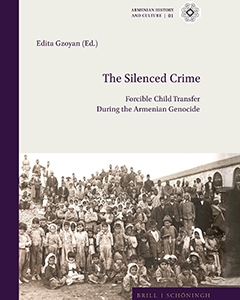
New Publication Marking the 110th Anniversary of the Armenian Genocide
The Silenced Crime: Forcible Child Transfer During the Armenian Genocide
16.04.2025
In commemoration of the 110th anniversary of the Armenian Genocide, the Armenian Genocide Museum-Institute (AGMI) presents The Silenced Crime: Forcible Child Transfer During the Armenian Genocide, a scholarly volume edited by AGMI Director Dr. Edita Gzoyan.
This publication features contributions from AGMI researchers Dr. Edita Gzoyan, Dr. Regina Galustyan, Dr. Narine Margaryan, Dr. Shushan Khachatryan, Dr. Robert Tatoyan, Dr. Harutyun Marutyan, and French-Armenian historian Dr. Raymond Kévorkian, Chair of AGMI’s Board of Trustees. The volume is published in collaboration with the Institute for Armenian Studies at Yerevan State University and constitutes the inaugural volume of the newly launched Armenian History and Culture series by Brill | Schöningh (Series link: https://brill.com/view/serial/AHUC). The series is co-edited by Dr. Ashot Hayruni and Dr. Robert Sukiasyan.
The contributors’ research focuses on various aspects of the forcible transfer and assimilation of Armenian children during the genocide—as a systematic policy by the Young Turk regime aimed at eradicating Armenian identity. Armenian children were targeted as part of a broader genocidal strategy: they were forcibly separated from their roots and placed in Muslim households or state-run orphanages. Through a combination of official decrees and individual initiatives, a systematic erasure of their national identity took place—through religious conversion, changes to personal data, and concealment of their true origins.

Deputy Prime Minister and Minister of Foreign and European Affairs of Slovenia Tanja Fajon Visits the Armenian Genocide Memorial
16.04.2025
On April 16, a delegation led by the Deputy Prime Minister and Minister of Foreign and European Affairs of the Republic of Slovenia, Tanja Fajon, visited the Armenian Genocide Memorial.
The guests were welcomed by Edita Gzoyan, Director of the Armenian Genocide Museum-Institute (AGMI), who accompanied them to the memorial and presented the history of its creation.
Ms. Tanja Fajon laid a wreath at the memorial commemorating the victims of the Armenian Genocide. The delegation then laid flowers at the Eternal Flame and observed a moment of silence in memory of the innocent victims.

Lithuanian Minister of the Interior Vladislav Kondratovič Visits the Armenian Genocide Memorial
15.04.2025
On April 15, a delegation led by the Minister of the Interior of the Republic of Lithuania, Vladislav Kondratovič, visited the Armenian Genocide Memorial, accompanied by Armenia’s Deputy Minister of the Interior Armen Mkrtchyan and Lithuania’s Ambassador to Armenia, Andrius Pulokas.
The guests were welcomed by Lusine Abrahamyan, Deputy Director for Museum Affairs at the Armenian Genocide Museum-Institute (AGMI). She guided the delegation through the memorial complex, providing an overview of its history and significance. Ms. Abrahamyan also spoke about the three khachkars (cross-stones) erected in memory of Armenians massacred during pogroms organized by the Azerbaijani authorities in Sumgait, Kirovabad (Gandzak), and Baku at the end of the 20th century. She also noted the graves of five freedom fighters buried near the Memorial Wall during the Artsakh liberation struggle, highlighting the historical parallels with the Armenian Genocide.

“The Armenian Woman: Victim and Heroine of the Genocide” Exhibition Opens in Bucharest, Romania
11.04.2025
As part of the commemoration of the 110th anniversary of the Armenian Genocide, the Armenian Genocide Museum-Institute (AGMI), in collaboration with Armenian embassies, diaspora organizations, and international institutions, is organizing various remembrance events dedicated to the innocent victims of the Genocide.
One such event was recently held in Romania’s capital, Bucharest, where the exhibition titled “The Armenian Woman: Victim and Heroine of the Genocide”, curated by AGMI, opened at the Rotonda Hall of the Romanian National Theatre. The exhibition was organized by the Armenian Cultural Center of the Armenian Union of Romania, in partnership with the Embassy of Armenia in Romania, the Armenian Apostolic Church Diocese of Romania, the Armenian Genocide Museum-Institute, and the Romanian National Theatre. It was followed by the opening of another exhibition titled “Strunga: A New Home for Armenian Orphans.”

The Armenian Genocide Memorial Now Included in the IWalk App
09.04.2025
We are pleased to announce that, as a result of cooperation between the Armenian Genocide Museum-Institute Foundation and the USC Shoah Foundation, the Armenian Genocide Memorial has been included in the IWalk mobile application. This marks an important step in raising global awareness and deepening education about the Armenian Genocide.
1. The IWalk app is available for download on both the App Store and Google Play Store.
2. The app is accessible in Armenian and English.
3. It is designed for a wide audience, including high school students and educators.
4. Users can select a guided “IWalk” and explore the content step by step by following designated stations within the memorial.
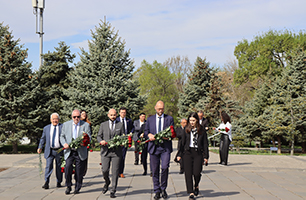
A Delegation Led by Christophe Quiniou, Mayor of Meyzieu, France, Visits the Armenian Genocide Memorial Complex
03.04.2025
On April 3, a French delegation led by Christophe Quiniou, Mayor of Meyzieu, visited the Armenian Genocide Memorial Complex. The group was accompanied by representatives of the Hrazdan Municipality, along with Olivier Decottignies, Ambassador Extraordinary and Plenipotentiary of France to the Republic of Armenia.
The delegation was welcomed by Lusine Abrahamyan, Deputy Director for Museum Affairs at the Armenian Genocide Museum-Institute (AGMI), who guided the guests through the Memorial Complex. During the tour, Abrahamyan provided historical context on the creation of the memorial and emphasized the significance of the three khachkars (cross-stones) erected in memory of Armenians killed during the late 20th-century pogroms in Sumgait, Kirovabad (Gandzak), and Baku.
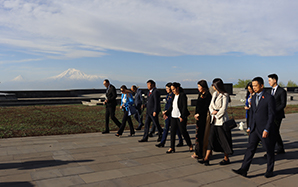
A Delegation Led by Ms. Le Thu Hai, Head of the Vietnam-Armenia Friendship Group, Visits the Armenian Genocide Memorial Complex
03.04.2025
On April 3, a delegation led by Ms. Le Thu Hai, Deputy Chief of Staff of the National Assembly of the Socialist Republic of Vietnam and Head of the Vietnam-Armenia Friendship Group, visited the Armenian Genocide Memorial Complex. The delegation was accompanied by Ms. Hasmik Hakobyan, Head of the Armenia-Vietnam Friendship Group of the National Assembly of Armenia.
The guests were welcomed by Dr. Edita Gzoyan, Director of the Armenian Genocide Museum-Institute (AGMI), who provided a guided tour of the Memorial Complex and spoke about the history of its establishment.
Ms. Le Thu Hai laid a wreath at the memorial in tribute to the victims of the Armenian Genocide. The delegation then placed flowers at the eternal flame and observed a moment of silence in memory of the innocent victims.
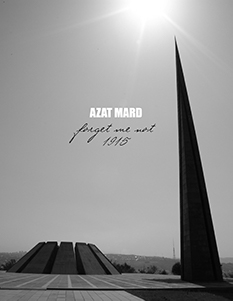
Garen Chobanyan, Founder of Azat Mard, Donates to the Armenian Genocide Museum-Institute
01.04.2025
As we near the 110th anniversary of the Armenian Genocide, the Armenian Genocide Museum-Institute (AGMI) has received a generous donation from Azat Mard, a company founded by Garen Chobanyan, a descendant of genocide survivors. This donation is aimed at supporting the technical development of the Museum through the modernization of essential equipment.
The AGMI extends its sincere appreciation to Garen Chobanyan, whose unwavering commitment to Armenia is evident in every endeavor he undertakes. Azat Mard has been actively involved in numerous charitable initiatives across Armenia, and this latest contribution stands as yet another powerful example of efforts to preserve and promote Armenian heritage, culture, and national identity.

Deputy Prime Minister for Foreign and European Affairs of Montenegro, Filip Ivanović, Visits the Armenian Genocide Memorial
31.03.2025
On March 31, the Deputy Prime Minister for Foreign and European Affairs of Montenegro, Mr. Filip Ivanović, visited the Armenian Genocide Memorial, accompanied by Deputy Foreign Minister of Armenia Paruyr Hovhannisyan.
The delegation was welcomed by Director of the Armenian Genocide Museum-Institute (AGMI) Edita Gzoyan, who accompanied the guests to the memorial and presented the history of its establishment. Dr. Gzoyan also spoke about the three khachkars (cross-stones) placed on the grounds of Tsitsernakaberd in memory of Armenians killed in the Azerbaijani-organized massacres in Sumgait, Kirovabad (Gandzak), and Baku at the end of the last century. She also referred to the stories of five Armenian freedom fighters buried opposite the Memory Wall, who died during the Artsakh (Nagorno-Karabakh) liberation war—highlighting the connection between these events and the Armenian Genocide.

President of Germany Frank-Walter Steinmeier Visits the Armenian Genocide Memorial
31.03.2025
On March 31, President of the Federal Republic of Germany Frank-Walter Steinmeier visited the Armenian Genocide Memorial in Yerevan. He was accompanied by Armenia’s Minister of Economy Gevorg Papoyan, Deputy Minister of Foreign Affairs Vahan Kostanyan, First Deputy Mayor of Yerevan Armen Pambukhchyan, Armenia’s Ambassador to Germany Viktor Yengibaryan, and Germany’s Ambassador to Armenia Claudia Bubb.
The guests were welcomed by Dr. Edita Gzoyan, Director of the Armenian Genocide Museum-Institute, who guided them to the memorial and presented the history of its creation and significance. Dr. Gzoyan also spoke about the three cross-stones (khachkars) located within the Tsitsernakaberd complex, dedicated to the memory of Armenians who were massacred in the late 20th century in Sumgait, Kirovabad (Gandzak), and Baku by the Azerbaijani government, highlighting the continuity between these atrocities and the Armenian Genocide.
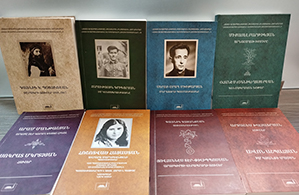
Anonymous Donation Brings Genocide Survivor Memoirs to Schools Participating in AGMI Programs
19.03.2025
An anonymous Armenian benefactor has recently made a generous contribution by purchasing 36 copies each of eight Armenian-language volumes from the Memoirs of Armenian Genocide Survivors series, published by the Armenian Genocide Museum-Institute (AGMI). The selected volumes—3 through 7, 9, 10, and 12—were acquired from the AGMI bookstore and donated to the Museum’s Educational Programs Department for distribution to school libraries.
Thanks to this thoughtful donation, two schools currently participating in AGMI’s educational programs have already enriched their libraries with these valuable memoirs.
These personal narratives and survivor testimonies serve as an essential resource for both education and research on the Armenian Genocide. It is vital that students engage with these firsthand accounts to deepen their understanding of history, memory, and resilience.

Delegation Led by Ondřej Benešík, Chair of the Committee on European Affairs of the Chamber of Deputies of the Czech Republic, Visits the Armenian Genocide Memorial
18.03.2025
On March 18, a delegation led by Mr. Ondřej Benešík, Chair of the Committee on European Affairs of the Chamber of Deputies of the Czech Republic, visited the Armenian Genocide Memorial, accompanied by H.E. Petr Pirunčík, Ambassador Extraordinary and Plenipotentiary of the Czech Republic to Armenia.
The guests were welcomed by Lusine Abrahamyan, Deputy Director for Museum Affairs at the Armenian Genocide Museum-Institute (AGMI). She guided the delegation through the memorial complex, presenting the history of its establishment.
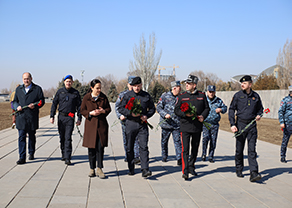
Commander of the Public Security Service of the Republic of Lithuania, Major General Viktoras Grabauskas Visited The Armenian Genocide Memorial and Musuem
11.03.2025
On March 7, a delegation led by Major General Viktoras Grabauskas, Commander of the Public Security Service of the Republic of Lithuania and international expert, visited the Armenian Genocide Memorial. The visit took place within the framework of the "Support to Law Enforcement and Security Sector Reforms in Armenia" program.
The delegation was welcomed by Dr. Edita Gzoyan, Director of the Armenian Genocide Museum-Institute (AGMI), who provided a guided tour of the Armenian Genocide Memorial Complex and shared the history of its establishment. Dr. Gzoyan also drew attention to the three khachkars (cross-stones) installed at Tsitsernakaberd in memory of Armenians killed in the massacres organized by the Azerbaijani government in Sumgait, Kirovabad (Gandzak), and Baku at the end of the 20th century.
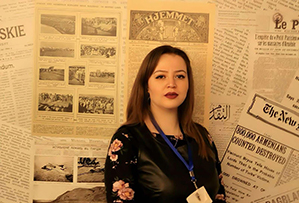
Funding Secured for Two AGMI Scientific Projects within the Framework of 2025 Research Support Programs
02.03.2025
Two scientific projects from the Armenian Genocide Museum-Institute (AGMI) have been awarded funding within the framework of the “Granting Program for Improving Scientific Efficiency – 2025” and the “Youth Scientific Research Support Program – 2025”, both initiatives of the Committee on Higher Education and Science.
The project titled “Turkish-Azerbaijani Language Propaganda Discourse”, led by AGMI researcher, PhD, and Associate Professor Elina Mirzoyan, has been selected for funding under the “Scientific Efficiency Promotion Grant Program – 2025.” The research will be carried out by a multidisciplinary team from various AGMI departments, with Dr. Bedros Der Matossian, Professor of History at the University of Nebraska–Lincoln, participating as the international partner.

Manushian Week in Armenia
01.03.2025
From March 14 to 18, Yerevan and Artashat hosted "Manushian Week," an event dedicated to Misak Manushian and his comrades-in-arms in the French Resistance movement. The Armenian Genocide Museum-Institute (AGMI) was among the participating institutions.
As part of the program, AGMI hosted an international conference titled “From CUP Nationalism to Nazism: Armenian Genocide Survivors at the Forefront of the Resistance Movement,” which took place on March 15 and 16.
The goal of Manushian Week was to redefine the legacy of Misak Manushian, highlight his contribution to the global resistance movement, and foster French-Armenian historical and cultural dialogue.
The program included a wide array of events such as theatrical performances, conferences, exhibitions, documentary film screenings, and panel discussions. Highlights included the presentation of the book “Misak Manushian: Through the Eyes of an Eyewitness,” performances of the play “Manushian...,” the premiere of Shoshana Bukhobza’s play “Manushian,” and a screening of Katya Giragosyan’s documentary “Misak and Meline.”
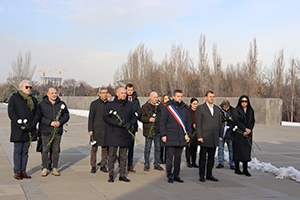
Mayor of Saint-Étienne Visits Armenian Genocide Memorial Complex
01.03.2025
On March 1st, a delegation led by Gaël Perdriau, Mayor of Saint-Étienne, visited the Armenian Genocide Memorial Complex, accompanied by Kapan’s Deputy Mayor, Gor Tadevosyan. The delegation also included Vrezh Khosrovyan, President of the Armenian Association of Saint-Étienne, and Jean-Pierre Kotchian, the Mayor’s advisor and a descendant of an Armenian Genocide survivor.
The guests were received by Dr. Edita Gzoyan, Director of the Armenian Genocide Museum-Institute (AGMI), who guided them through the Memorial Complex and shared the history of its creation.
During the visit, Mayor Perdriau laid a wreath at the monument commemorating the victims of the Armenian Genocide. The delegation then placed flowers at the eternal flame and observed a minute of silence in memory of the innocent victims.
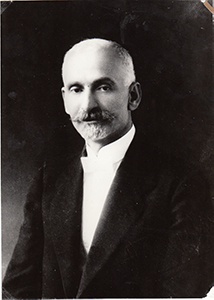
NATIONAL FIGURE HOVHANNES TOUMANYAN
19.02.2025
In parallel to orphan care activities Hovhannes Toumanyan has initiated and realized a number of projects aimed at solving the consequences of the Armenian Genocide.
On March 1918, the Union of Armenian Compatriotic Unions was established under the presidency of Hovhannes Toumanyan. Concentraiting the activities of the patriotic unions established in different Armenian provinces around him, Hovh. Toumanyan has carried out extensive work to organize fundraising to provide material support to the Armenian refugees, as well as ensure the peaceful coexistence of Armenians with neighboring nations (including Muslims). On behalf of the Union of Armenian Compatriotic Unions and the Armenian Writers Union, Toumanyan has called on the parliaments, academies, universities, and scientific societies of different countries in the world, describing the hard plight of the Armenian people and asking for moral and material aid.
On 31 October 1918, the day after the defeat of the Ottoman Empire in World War I and the conclusion of the Mudros armistice, a meeting of the Central Council of the Armenian Compatriotic Unions was held in Tbilisi, where it was decided to submit a memorandum to the Paris Peace Conference to be held in 1919. In order to prepare the memorandum War Victims Relief Committee was established under the leadership of Hovhannes Toumanyan. In a short time this state committee has undertaken an extensive work to record and legalize the human and material losses of Armenian people during the war.
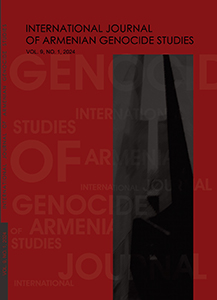
International Journal of Armenian Genocide Studies 2024
issues 1 and 2
18.02.2025
Read the following articles in the latest 2 issues of the International Journal of Armenian Genocide Studies, published by the Armenian Genocide Museum-Institute Foundation:
International Journal of Armenian Genocide Studies, Vol. 9 No. 1 (2024)
• Nagothu Naresh Kumar, Networks of Denial and Justification: South Asia Responses to the Armenian Genocide
• Ozlem Karakus, Echoes of Loss: Examining Gendered Violence and Legacy in the Armenian Genocide
• Sossi Tatikyan, Legal and Political Aspects of the De-Armenization of Nagorno-Karabakh: Ethnic Cleansing, Genocide, Forced Displacement or Voluntary Exodus?
• David Hackett, "Sieves of Responsibility" - Connecting Failures of Genocide Prevention and Geopolitical Interests to Atrocity in Nagorno Karabakh
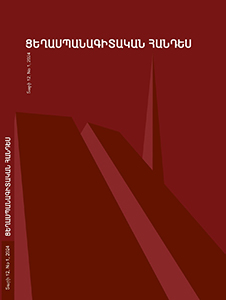
Journal of Genocide Studies 2024
Issues 1 and 2
15.02.2025
Read the following articles in the latest 2 issues of the Journal of Genocide Studies, published by the Armenian Genocide Museum-Institute Foundation:
Issue 1, 2024;
• Robert A. Tatoyan, The Armed Resistance of the Exiled Zeytun Armenians in the Desert of Der Zor
• Verjine G. Svaslian, The Armenian Woman During the Genocide and Self-Defense Heroic Struggles: Episodes
• Anna A. Kazaryan, The Forced Deportation of the Armenian Population from the Kghi District of Erzurum Province: From Kghi to Der Zor
• Narek M. Poghosyan, Contemporary Threats of the Implementation of the Genocide

French Audio Guides Now Available at the Armenian Genocide Museum-Institute
14.02.2025
Thanks to the cooperation and financial support of the leadership of France’s Auvergne-Rhône-Alpes region, the Armenian Genocide Museum-Institute has introduced French-language audio guides. The museum's existing guide texts have been translated into French and professionally recorded, allowing Francophone visitors to explore the exhibits independently. Given the significant number of French-speaking visitors, the addition of these audio guides is both necessary and valuable.
Collaboration with the Auvergne-Rhône-Alpes region began in 2020, resulting in the publication of a French-language edition of The Slaughtered Armenia: The Story of Aurora Mardiganian. Most recently, with the region’s financial support, a French edition of The Armenian Genocide and its Consequences by historian and Chairman of the Armenian Genocide Museum-Institute Board of Trustees, Raymond Kévorkian, has also been published.
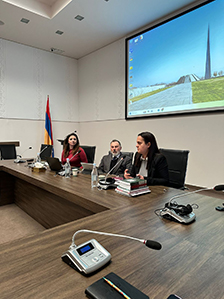
The presentation of the book “Secret Nation: The Hidden Armenians of Turkey (I.B. Tauris, 2018)” by Avedis Hadjian at AGMI
11.02.2025
On February 6, a presentation and discussion of Avedis Hadjian’s book Secret Nation: The Hidden Armenians of Turkey (I.B. Tauris, 2018) took place at the Armenian Genocide Museum-Institute. Before the event began, Edita Gzoyan, the Director of the Museum-Institute, greeted the attendees. Shushan Khachatryan, Head of the Department for Documentation and Research on the Victims and Survivors of the Armenian Genocide, then introduced the speaker.
Avedis Hadjian presented his book, which is made up of 32 chapters, each dedicated to a specific geographic and cultural region: Sasun, Commagene, Diyarbekir, Taron, Karin, Sebastia, Asia Minor, Kharberd, Van, Cilicia, the Black Sea, and Hamshen. The author conducted his research using interviews and oral history methods, traveling to these regions and engaging with individuals and families who, due to the Armenian Genocide, had either lost their Armenian identity but still retained some memory of their roots, or those who still identified as Armenians—including some who were hidden Christian Armenians.
The author presented unique photographs, each accompanied by the story behind it. At the end of the presentation, he responded to questions from the audience.
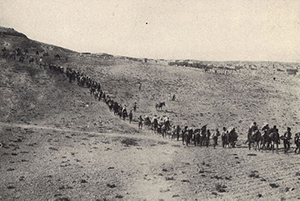
We continue to highlight the publications of AGMI researchers in international journals
07.02.2025
An article by Edita Gzoyan, Director and Senior Researcher at the Armenian Genocide Museum-Institute (AGMI), titled "From War Crimes to Crimes against Humanity and Genocide: Turkish Responsibility after World War I," has been published in Genocide Studies International: https://utppublishing.com/doi/10.3138/GSI-2022-0020.
The article examines the work of the Commission on the Responsibility of the Authors of the War and Enforcement of Penalties, established after World War I to investigate war crimes, including those committed against Armenians during the Armenian Genocide.
Drawing on evidence from various sources, the Commission’s report explicitly identifies the crimes perpetrated by the Young Turk government against the Armenian population of the Ottoman Empire, namely:
1. Mass killings, massacres, and systematic terror.
2. Abduction of women and young girls.
3. Deportation of civilians.
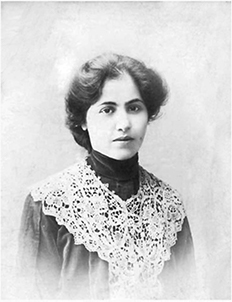
ZABEL YESSAYAN, 1878-1943
04.02.2025
Zabel Yessayan was born on February 4th, 1878, in Constantinople (Istanbul). After graduating from the Holy Cross school in Uskudar, she went to Paris in December 1895, where she attended lectures on literature and philosophy at the Sorbonne and the College de France.
She married the artist Dikran Yessayan (1874-1921) in 1900. After considerable activity in the literary and public fields in Paris, she returned to Constantinople in 1902, where she continued her literary activities.
Due to the social and national-political repression and persecution that began after the attempt on Sultan Abdul-Hamid II’s life, she was forced to return to Paris, where she lived until 1908.
Zabel Yessayan spent about three months in Adana, Mersin, Sis, and other places after the massacres, meeting eyewitnesses and survivors and writing a number of works describing what she saw and heard (In the Ruins, The Curse, The New Bride, Safie).
She was on the secret list of intellectuals to be deported on the night of April 24th. Escaping deportation, she spent several months living in disguise, after which she went to Bulgaria, Romania, and, eventually, at the end of 1915, the Caucasus. She had a number of meetings in both Baku and Tiflis (Tbilisi), joined various important enterprises, and gave lectures. She went to St. Petersburg and Moscow at the invitation of the Moscow Armenian Committee, where she organized fundraising for the benefit of Armenian orphans and presented the real picture of the Armenian massacres.
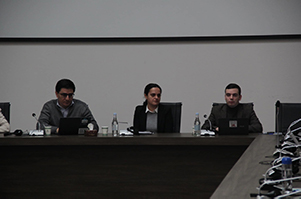
ARMENIA AND THE INTERNATIONAL CRIMINAL COURT: ONE YEAR OF MEMBERSHIP
Workahop at AGMI
04.02.2025
On February 1, a professional seminar titled “Armenia and the International Criminal Court (ICC): One Year of Membership” was held at the Armenian Genocide Museum-Institute. The seminar was organized jointly by the Union of International Lawyers of Armenia and the Museum-Institute. It brought together international law experts, legal professionals interested in international criminal law, individuals engaged in interdisciplinary studies, as well as professors and students.
The event began with a welcoming speech by Edita Gzoyan, Director of the Museum-Institute. Drawing historical parallels, Edita Gzoyan emphasized that after the Armenian Genocide, there was no international law or court to punish the perpetrators, but now the situation has changed. She expressed hope that Armenia's membership in the ICC would also provide a legal framework to fight for the rights of our compatriots forcibly displaced from Artsakh.
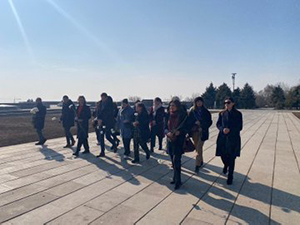
Representatives of Local Government Bodies of France Visit the Armenian Genocide Memorial Complex
03.02.2025
At the invitation of the United Nations Development Program (UNDP) and the French Embassy in Armenia, representatives of France's local government bodies visited the Armenian Genocide Memorial Complex on February 2, accompanied by the Ambassador Extraordinary and Plenipotentiary of France to Armenia, Olivier Decottignies, and representatives of the UNDP.
They were greeted by Lusine Abrahamyan, AGMI Deputy Director for Museum affairs. She guided the visitors to the Memorial Complex, sharing the history of its establishment. The Deputy Director also spoke about three khachkars (cross-stones) installed in the Tsitsernakaberd area, which commemorate the Armenians who were victims of the massacres organized by the Azerbaijani government in the cities of Sumgait, Kirovabad (Gandzak), and Baku at the end of the last century. She also presented the stories of five freedom fighters who were buried near the Memorial Wall during the Artsakh Liberation War, emphasizing the connection between these events and the Armenian Genocide.

Georgian Foreign Minister Maka Bochorishvili visited the Armenian Genocide Memorial Complex
30.01.2025
On January 30, Maka Bochorishvili, the Minister of Foreign Affairs of Georgia, arrived in Armenia on an official visit and visited the Armenian Genocide Memorial Complex.
The Georgian minister was greeted by Edita Gzoyan, Director of the Armenian Genocide Museum-Institute (AGMI), who guided her to the Memorial Complex and shared the history of its establishment. The Director also spoke about the three khachkars (cross-stones) placed in the Tsitsernakaberd area to commemorate the Armenians who were victims of the massacres organized by the Azerbaijani government in the cities of Sumgait, Kirovabad (Gandzak), and Baku at the end of the last century, emphasizing the connection between these events and the Armenian Genocide.
The Georgian Minister laid a wreath at the memorial to honor the victims of the Armenian Genocide. Afterward, the guests placed flowers near the Eternal Fire and observed a minute of silence to pay their respects to the innocent martyrs of the Armenian Genocide.
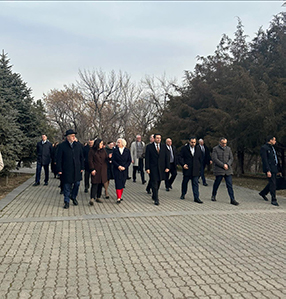
Representatives of the Parliaments of Northern Europe and the Baltic States (Nordic-Baltic-8) Visited the Armenian Genocide Memorial Complex
23.01.2025
On January 23, 2025, representatives of the parliaments of Northern Europe and the Baltic countries (Norway, Finland, Estonia, Latvia, Lithuania, Sweden, and Denmark), including the Speakers of the Parliaments of Norway, Finland, Estonia, and Latvia, as well as the Deputy Speakers of the Parliaments of Sweden, Lithuania, and Denmark, visited the Armenian Genocide Memorial Complex, accompanied by Alen Simonyan, the Speaker of the National Assembly of Armenia.
The delegation was welcomed by Edita Gzoyan, Director of the Armenian Genocide Museum-Institute (AGMI), who guided the visitors to the Memorial Complex and shared the history of its establishment.
The members of the Northern European and Baltic delegations laid wreaths at the memorial dedicated to the victims of the Armenian Genocide. Afterward, they placed flowers around the Eternal Fire and observed a minute of silence in memory of the innocent martyrs.
Dr. Gzoyan also guided the visitors to the Memory Wall presenting its history. Behind the wall, in special niches, are small urns filled with soil taken from the graves of various foreign public figures, political leaders, intellectuals, and missionaries who raised their voices in protest against the mass massacres and genocide of Armenians carried out by the Ottoman government in the late 19th and early 20th centuries.
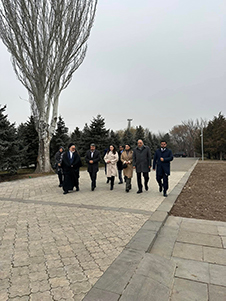
The Iran-Armenia Friendship Group of the Majlis of the Islamic Republic of Iran visited the Armenian Genocide Memorial Complex
14.01.2025
A delegation led by Ara Shahverdyan, head of the Iran-Armenia Friendship Group of the Majlis of the Islamic Republic of Iran, visited the Armenian Genocide Memorial Complex on January 14.
The guests were greeted by Lusine Abrahamyan, AGMI Deputy Director for Museum affairs. She guided the visitors to the Memorial Complex, sharing the history of its establishment. The Deputy Director also spoke about three khachkars (cross-stones) installed in the Tsitsernakaberd area, which commemorate the Armenians who were victims of the massacres organized by the Azerbaijani government in the cities of Sumgait, Kirovabad (Gandzak), and Baku at the end of the last century. She also presented the stories of five freedom fighters who were buried near the Memorial Wall during the Artsakh Liberation War, emphasizing the connection between these events and the Armenian Genocide.
Dear visitor,
The Armenian Genocide Museum-Institute will be closed from December 30 till January 2, 2025.
Sincerely,
The Armenian Genocide Museum-Institute Foundation
| 




